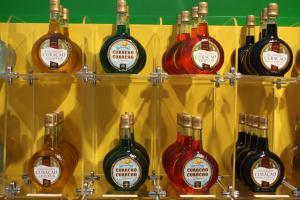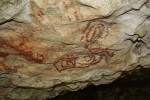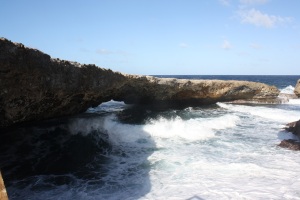
Photo by Richard Varr
By Richard Varr
The ornate cornices and gables on Willemstad’s colorful waterfront buildings highlight some of the most interesting architecture in the Caribbean. The buildings are remarkably Dutch, yet facades are not tinted with dark browns and earthen reds to stave off chilled northern winds, but instead with Caribbean blues, tropical greens and sunshine yellows – a pleasing touch of Amsterdam graced by brilliant light and warm ocean breezes.

Willemstad’s waterfront buildings. Photo by Richard Varr
The buildings are a reminder of how Curaçao was governed and influenced by the Dutch who claimed the island in 1634, and since then have helped shaped its history and culture. That was about the time when Dutch Governor Peter Stuyvesant first set foot on the island, setting up commerce and trade through the Dutch West India Company.

Synagogue with its sand floor. Photo by Richard Varr
Today, towns, streets, hotels and restaurants have Dutch names. Colonial history is alive at some of the old plantation houses, in the archeological and maritime museums, and at the island’s Postal Museum that exhibits a collection of Netherlands stamps, antique mailboxes and scales.
Like Holland, Curaçao has espoused racial tolerance through the years and has opened its doors to many faiths. I visited Willemstad’s Mikvé Israel-Emanuel Synagogue, the oldest synagogue in continuous use in the Western Hemisphere. Inside are sand floors and four central pillars that surprisingly have names: Rachel, Rebecca, Leah and Sarah. Chandeliers date back to 17th century, and the synagogue’s museum houses early 18th century silver.
The ‘Swinging Old Lady’

On the Queen Emma Pontoon Bridge. Photo by Richard Varr
A favorite pastime for me while in Willemstad was sitting along the waterfront with a cold beer and watching passing cruise ships, tankers, pleasure craft and busy tug boats passing along the canal-like St. Anna Bay. When ship traffic passes, Willemstad’s famous Queen Emma Pontoon Bridge connecting the city’s Punda and Otrobanda quarters swings open and closed, taking up to several minutes to slowly glide atop the water. Below is video I shot of the “Swinging Old Lady” closing after ship traffic.
Finding the Perfect Dutch Gift

Gouda cheese. Photo by Richard Varr
You won’t have to look too far and wide to find Dutch souvenirs amidst shelves of Spanish Lladró and German Hummel figurines, for example, or sparkling Safire and diamond-studded jewelry. One of the biggest sellers is Delft Blue porcelain and ceramics – everything from plates and tea sets to tiles, candle holders and decorative windmills and classic replica Dutch house mantelpieces. There are hand-embroidered linens from Holland, Dutch wooden shoes and clogs, and even decorative wooden tulips. Particularly popular are wheels of Dutch Gouda cheese that are easy to take home. Stores, shops and boutiques line the main shopping streets in the Punda and Otrobanda districts.

Curacao Liqueur. Photo by Richard Varr
Curaçao Liqueur is unique to the island, made from the peels of local laraha oranges. 2014 marks 119 years that the liqueur is produced and sold on the island, with a maximum output of up to 10,800 liters a month. It comes in four flavors: original, coffee, rum raisin and chocolate.

Floating Market. Photo by Richard Varr
Curaçao’s Floating Market, with vendor stand after stand of fresh produce, celebrates its 100th anniversary in 2014. “It started when the refinery came to the island because people needed more food,” says city tour guide Emlyn Pietersz. Vendors’ boats line up along the waterfront behind produce stands brimming with pineapples, potatoes, papayas, yams, limes and oranges. “Venezuelan merchants sail for eight hours to sell their goods,” says Emlyn.

Mount Christoffel. Photo by Richard Varr
Curaçao’s Rugged Side – Grottos, Caves, Cacti and Wildlife

Cave drawings.
I spent a couple of days venturing outside Willemstad to the island’s rugged sides. I hiked amidst the winding trails of Christoffel National Park, along hills with fields of cactus, flora and fauna. The park also has Amerindian drawings in caves and abundant wildlife, making it ideal for birding.

Park Ranger Briand Victorina. Photo by Richard Varr
Perhaps the most strenuous hike leads to the summit of the 1,239-foot-high Mt. Christoffel. Park Ranger Briand Victorina tells me it takes – for more adventurous climbers – maybe an hour or more up and an hour back down the mountain. “When you reach the top, you feel like you’re in heaven,” he says.

Natural Bridge. Photo by Richard Varr
Just across from the airport, the Hato Caves have water pools, limestone formations and easy walking paths to trek through the cave system’s many chambers. My biggest thrill was feeling the saltwater spray from the crashing surf of Boka Tabla, one of the stunning grottos formed by the waves at Shete Boka National Park on Curaçao’s rugged northern shoreline. At one rocky cove is a stone bridge like Aruba’s Baby Natural Bridge.
Medicinal Herbs – Garden of Cures

Den Paradera. Photo by Richard Varr
Den Paradera is where I found an organic herb garden and where local Curaçao plants are categorized according to their traditional medicinal uses. Garden owner Dinah Veeris grows herbs and plants she claims can cure all kinds of ailments. She also sings to sick plants to help them heal, as seen in the below video.
The Saltwater Pool at the Renaissance Curaçao Resort and Casino

Renaissance Hotel. Photo by Richard Varr
While in Curaçao, I stayed at this waterfront Renaissance Hotel with all the upscale quality of a Marriott property. It’s located by the Mega Pier for cruise ships in the heart of Willemstad along the Otrobando waterfront, and just a five minute walk from the Queen Emma Bridge.

Infinity salt water pool with sand beach. Photo by Richard Varr
Besides the great breakfast buffet, I was especially impressed with the hotel’s heated saltwater pool – unlike any I’ve ever seen. Outside the hotel on the second level, the pool area is actually made to look like a beach with a sandy shoreline. Lounge chairs, palm trees and a “beach-side” bar add to the ambiance. Saltwater is pulled from the sea, heated and recycled. I thought I’d miss the beach staying in this city hotel, but I found the saltwater pool a satisfying tradeoff. There’s no choppy surf or jagged shells you might step on, and the ocean views with the sunset are simply fabulous reflecting off both the Caribbean Sea and the pool water as well.

Rif Fort. Photo by Richard Varr
Part of the hotel complex, the adjacent Rif Fort is one of the island’s old coral stone forts that now houses shops and restaurants. “It’s where soldiers once slept and there were prisons as well,” says resort spokeswoman Ashari Rombley Mendes Nieves. “The top parts of the fort on the second floor once had cannons at each opening of the walls to protect Curaçao from pirates and enemies trying to invade the harbor.”

Willemstad Waterfront. Photo by Richard Varr
